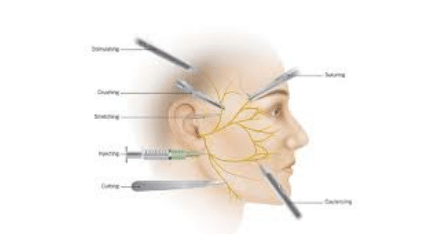A facelift, sometimes referred to as a rhytidectomy, is a treatment used in cosmetic surgery to reduce the appearance of aging in the midface and neck. A facelift is designed to produce transformative yet natural-looking results. It is customized to each patient based on their unique aesthetic goals.
There are dangers associated with any surgery. Even though face lifting operations are typically considered safe when carried out by a skilled facial cosmetic surgeon. One of the most significant risks during rhytidectomy is nerve damage. Luckily most of the time, nerves have the ability to regenerate.. Want to know more about nerve regeneration after a facelift? Read on!
Nerve damage after a facelift

Nerve injury can happen when the skin is cut, whether by a surgeon’s scalpel or the edge of a piece of paper. The stretching or cauterization of nerves can also result in nerve injury.
Types of nerve injury
Nerve injury can be either temporary or permanent. The skin around a scar is the most typical location for transient nerve injury.
You feel less feeling on the surrounding skin as well as on the damaged skin itself when you have transient nerve injury. This is typical and to be anticipated.
Minor and transient nerve injury gradually disappears over time. However, numbness and the inability to move the damaged muscle will be permanent if a nerve is entirely severed.
Is nerve damage after a facelift common?

The risk of nerve injury varies based on the patient’s anatomy, external circumstances, and the type of facelift treatment used. Nerve damage following a facelift is uncommon.
The Great Auricular Nerve (GAN) is one of the many facial nerve bundles. It is the most frequently hurt nerve during facelift surgery. The lower half of the ear, through the jawline, and a few inches behind the center of the ear are all included in the GAN pathway.
According to some studies, the GAN can be injured at 6% to 7%. However, the majority of patients subsequently regain normal sensibility.
Working with a highly skilled facial cosmetic or plastic surgeon will help lower the chance of this consequence. Yet, nerve injury following a facelift should be considered an exception rather than the rule.
Symptoms of facial nerve damage
Symptoms of nerve injury may include:
- Pain
- numbness
- weakness
- partial paralysis of the face
- trouble smiling
- trouble closing one’s eyes
- drooping eyelids or mouth corners
- an unbalanced appearance.
A patient’s ability to control their facial muscles may also be compromised. This could lead to a change in appearance and variable facial expressions. Additionally, there could be a lack of feeling in specific facial regions.
Time for nerve regeneration after facelift
Within one to two weeks following surgery, facial nerve sensation will return. But, the neck region may take up to six weeks. Most patients regain complete facial sensation within a few months. But it can take up to a year for some.
As nerve endings regenerate, patients may experience numbness or tingling during healing. Swelling and brief headaches are frequent side effects of this procedure. These side effects usually appear within the first two weeks following surgery. For their surgeon to keep track of their recovery, patients should watch for any indications of infection. Patients must also attend all follow-up appointments.
Restoring facial nerve damage after a facelift
Facial nerve damage is often repaired using a multifaceted strategy following a facelift. It is to reestablish the connection between the brain and the facial nerves.
Medication
When modest nerve damage is found, your surgeon would probably suggest medication. This is to relieve discomfort and inflammation brought on by facial nerve damage.
Botulinum toxin type A can be injected into particular areas. It will lessen muscle spasms obstructing healthy nerve signaling.
Physical Therapy
Special exercises can assist in retraining facial muscles and nerves. Regimens like massage and physical therapy are frequently advised to improve facial muscular strength. Additionally, neuron regeneration can be accelerated and improved with electrical stimulation.
Surgery
In rare instances, specialized surgery may be necessary. It may be to remove the impaired nerve and reconnect healthy nerve ends. It can also be to replace the injured nerve with a nerve graft.
If you suffer a nerve injury, your surgeon will schedule additional follow-up sessions. They will monitor your progress and ensure you receive appropriate therapy. Early diagnosis and ongoing treatment are essential to healing nerve damage.
Tips to help with nerve regeneration after facelift
You might need to change your way of life:
- Your quality of life and sense of well-being can both be enhanced by leading a healthy lifestyle.
- Eat a balanced diet and get frequent exercise.
- Keep yourself as healthy and active as you can to maintain flexibility.
- Instead of attempting to complete everything immediately, plan daily tasks in manageable chunks.
- Talk to your doctor about possible solutions if discomfort keeps you up at night.
To reduce the danger of nerve damage, select a facial cosmetic surgeon who is board qualified.
Selecting a skilled, board-certified facial cosmetic surgeon to conduct your facelift will increase your chances of preventing nerve injury.
Suppose your facial cosmetic surgeon is board certified. In that case, they have extensive experience performing facelifts using cutting-edge tools and surgical techniques. They thoroughly understand the underlying facial musculature, including where each facial and neck nerve bundle is located.
With these credentials, you may be sure your surgeon will take precautions. They will prevent damage to sensitive facial nerves. Yet, produce stunning, realistic-looking results.
You May Also Like:
- Elevate Their Craft: Unique and Practical Gifts for Woodcarvers
- Theater Gifts for Students: Great Presents for Budding Actors
FAQs
1. Why do I have tingling or pins and needles after having a facelift? Will it disappear?
A scalpel is used to cut the skin of the face around the ear and occasionally behind the ear during a facelift procedure. During this, a few tiny nerve fibers are severed. These nerves cannot be protected from being cut. These nerves are known as sensory nerves. They control skin sensation, as implied by their name. This encompasses pain, pressure, and touch.
Due to the cutting of these nerves, it is very typical to have numbness on the skin of your face following a facelift.
These nerves will eventually regrow, though. You can experience tingling and pins and needles on your face when they grow back.
In the long run, this is a good sign because it indicates that the sensation will very probably begin to return. People rarely experience a complete lack of feeling. The tingling and pins-and-needles sensation will eventually disappear.
2. When Can I Sleep On My Side After Facelift?
It depends. Most people can resume sleeping on their sides after 2 to 4 weeks. You can read more about sleeping on the side after a facelift here.
3. I had a facelift, but now my face no longer moves. Is there anything I can do to hasten the recovery of this?
No! After a facelift, it takes time for the swelling to subside in the nerves and for the nerves to heal. Nerves can heal slowly, which can be frustrating. But, most people heal quickly in days to weeks. However, for a few people, the healing can take months. The loss of movement after a facelift is very rarely permanent. Furthermore, if you ever notice a loss of function or the inability to move, you should contact a doctor immediately.
4. How To Get Rid Of Facelift Scars In Front Of Ears?
If you are worried about facelift scars, check this out.
Conclusion
Facelift is a surgical treatment used to improve the appearance of the face by disposing of excess pores, skin, and fats. While the risks of nerve damage are low, it’s a probable difficulty. Following the doctor’s instructions is essential if you experience nerve damage after a facelift. With time and patience, most people have nerve regeneration after facelift and recover completely.









